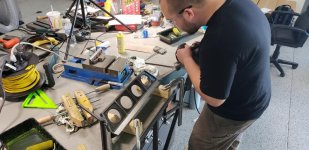Richard King
Diamond
- Joined
- Jul 12, 2005
- Location
- Cottage Grove, MN 55016
Hi I was going to add something to Paolo's Dennis Foster Feather Weight SE tread. I tried to delete the whole thing, but it wouldn't work.
These were done by my students during a class or after a class I taught them.
Steve Watkins in Texas Planing 2 SE's
Working on some straight edges... - YouTube
Warrens friend planing a KingWay SE
Planing of Straightedge - YouTube
Stefan G in Denmark Class
6 minute mark and 17 is interesting about SE Bending. Scraping class 217 in Denmark - YouTube
Keith Rucker after a class
Scraping a Camelback Straight Edge Flat - YouTube
also a couple of good ones from John Sanders of NYC CNC
What is Metal Scraping? - YouTube
Fast Forward to minute 16
Richard King Metal Scraping Class! - YouTube
You can also see several others about my classes, scraping and machine rebuilding by searching on You Tube "Richard King Scraping"
These were done by my students during a class or after a class I taught them.
Steve Watkins in Texas Planing 2 SE's
Working on some straight edges... - YouTube
Warrens friend planing a KingWay SE
Planing of Straightedge - YouTube
Stefan G in Denmark Class
6 minute mark and 17 is interesting about SE Bending. Scraping class 217 in Denmark - YouTube
Keith Rucker after a class
Scraping a Camelback Straight Edge Flat - YouTube
also a couple of good ones from John Sanders of NYC CNC
What is Metal Scraping? - YouTube
Fast Forward to minute 16
Richard King Metal Scraping Class! - YouTube
You can also see several others about my classes, scraping and machine rebuilding by searching on You Tube "Richard King Scraping"


 .
.



